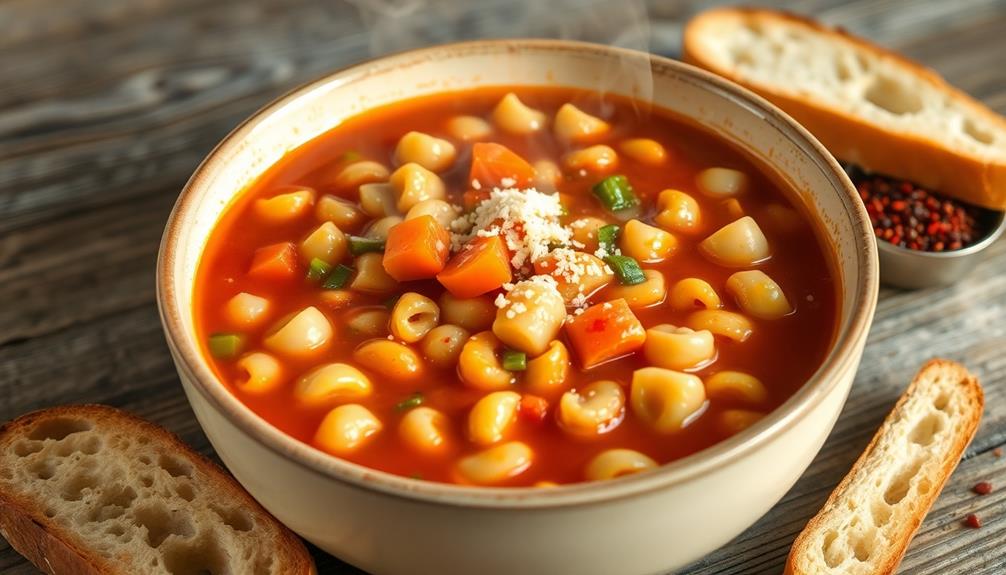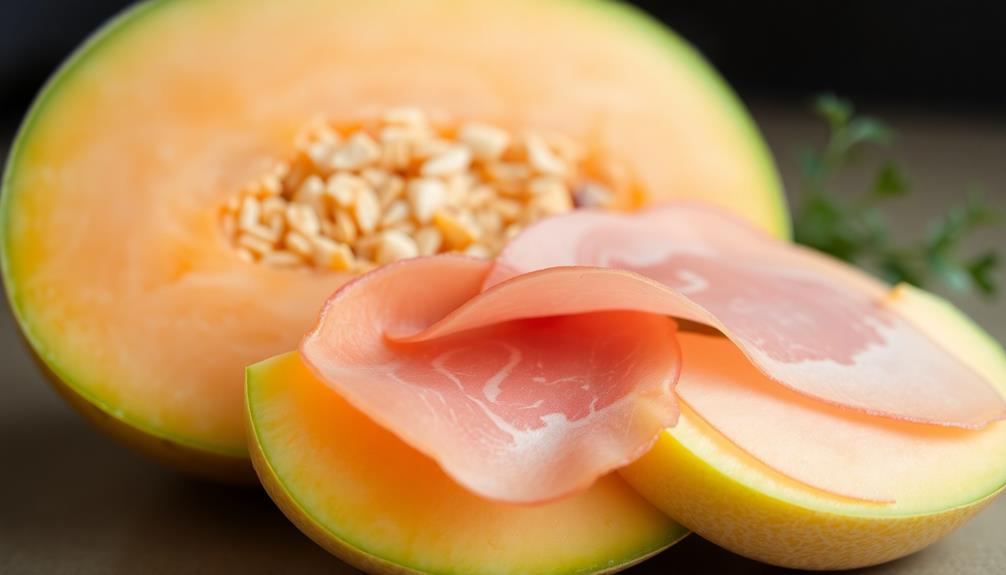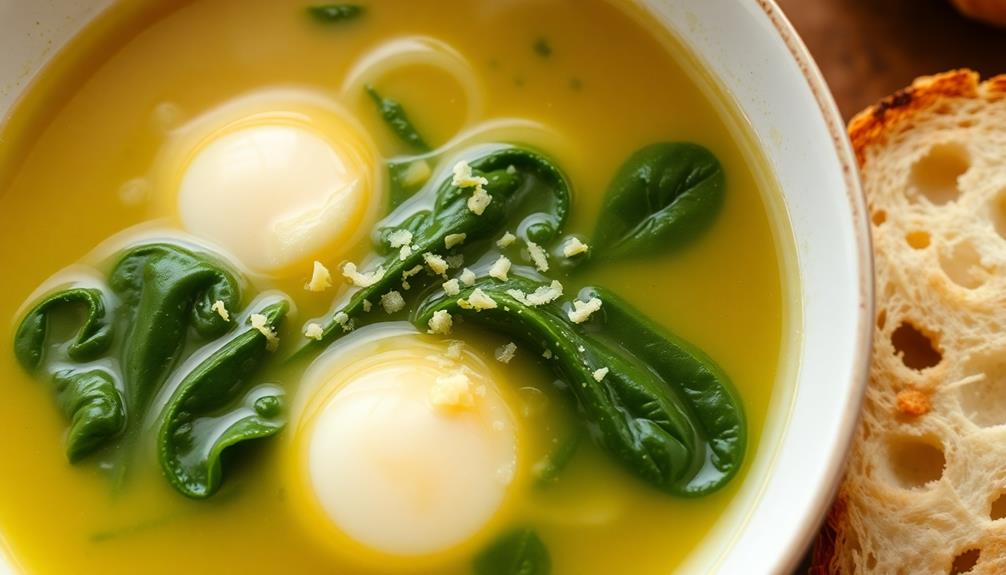Tiramisu is a delightful Italian dessert that'll make your taste buds dance! It's a no-bake treat with layers of coffee-soaked ladyfingers and creamy mascarpone cheese. You'll love how the coffee flavor blends perfectly with the sweet, fluffy filling. It's easy to make and perfect for family gatherings or special occasions. The best part? You can make it ahead of time, and it gets even tastier as it chills overnight. Don't forget to dust it with cocoa powder before serving for that classic look. There's so much more to discover about this "pick-me-up" dessert's history and recipe secrets!
Key Takeaways
- Tiramisu is an Italian dessert made with layers of coffee-soaked ladyfingers and mascarpone cheese cream.
- The name "tiramisu" means "pick me up" in Italian, reflecting its energizing coffee and sugar content.
- Key ingredients include mascarpone cheese, coffee, ladyfingers, cocoa powder, and often rum or marsala wine.
- Tiramisu is a no-bake dessert that requires chilling, typically overnight, to allow flavors to meld and texture to set.
- The dessert originated in the Veneto region of Italy in the 1960s and gained widespread popularity in the 1970s and 1980s.
History
Tracing the origins of tiramisu reveals a surprisingly recent history. You might think this beloved Italian dessert has been around for centuries, but it's actually quite young!
Tiramisu's story begins in the 1960s in the Veneto region of Italy. While there's some debate about its exact birthplace, most agree it was created in Treviso.
Here's what we know:
- The name "tiramisu" means "pick me up" in Italian
- It was likely invented by a restaurant owner or pastry chef
- The dessert quickly gained popularity in the 1970s and 1980s
You'll find different versions of tiramisu's creation story:
- Some say it was made to give energy to new mothers
- Others claim it was created as a sweet treat for workers
- A few believe it was invented to boost the spirits of World War I soldiers
No matter its true origins, tiramisu has become a global favorite.
You can now find this creamy, coffee-flavored dessert in restaurants and homes all over the world. It's a sweet reminder that delicious traditions can start at any time!
Recipe
Tiramisu, a beloved Italian dessert, is a delightful combination of creamy mascarpone cheese, coffee-soaked ladyfingers, and a dusting of cocoa powder. This no-bake treat is perfect for both casual gatherings and elegant dinner parties, offering a luxurious taste experience that's surprisingly easy to prepare.
While traditional tiramisu recipes often call for raw eggs, this version uses a cooked zabaglione to ensure food safety without compromising on flavor. The result is a luscious, velvety dessert with layers of bold coffee flavor and rich, creamy sweetness that's sure to impress your guests and satisfy your sweet tooth.
- 6 large egg yolks
- 3/4 cup granulated sugar
- 2/3 cup whole milk
- 1 1/4 cups heavy cream
- 1 pound (16 oz) mascarpone cheese, room temperature
- 1/2 cup strong brewed coffee or espresso, cooled
- 2 tablespoons rum or marsala wine (optional)
- 24-30 ladyfingers (savoiardi)
- 1/4 cup unsweetened cocoa powder
- Dark chocolate shavings for garnish (optional)
In a heatproof bowl, whisk together egg yolks and sugar. Place the bowl over a pot of simmering water, creating a double boiler. Whisk constantly for about 10 minutes until the mixture thickens and becomes pale yellow. Remove from heat and let cool.
In a separate bowl, whip heavy cream until stiff peaks form. Fold the cooled egg mixture into the mascarpone cheese, then gently fold in the whipped cream.
Mix coffee with rum or marsala wine if using. Quickly dip each ladyfinger into the coffee mixture and arrange in a single layer in a 9×13 inch baking dish. Spread half of the mascarpone mixture over the ladyfingers, then repeat with another layer of dipped ladyfingers and the remaining mascarpone mixture. Cover and refrigerate for at least 4 hours or overnight.
Before serving, dust the top with cocoa powder and garnish with chocolate shavings if desired.
For best results, use high-quality ingredients, especially when it comes to the mascarpone cheese and ladyfingers. Avoid over-soaking the ladyfingers, as this can make the dessert too soggy. If you prefer a stronger coffee flavor, you can brush additional coffee mixture onto the ladyfingers after arranging them in the dish.
For a non-alcoholic version, simply omit the rum or marsala wine. Tiramisu can be made up to 2 days in advance, making it an excellent make-ahead dessert for entertaining.
Cooking Steps
Let's start making your tiramisu!
You'll begin by whipping the mascarpone until it's light and fluffy, then mix egg yolks with sugar for a sweet base.
Next, you'll dip ladyfingers in a coffee mixture and layer them with the creamy mascarpone mixture, repeating until you've used all your ingredients.
After assembling, it's important to chill your tiramisu overnight before serving, allowing all the flavors to meld together perfectly.
Step 1. Whip Mascarpone Until Fluffy
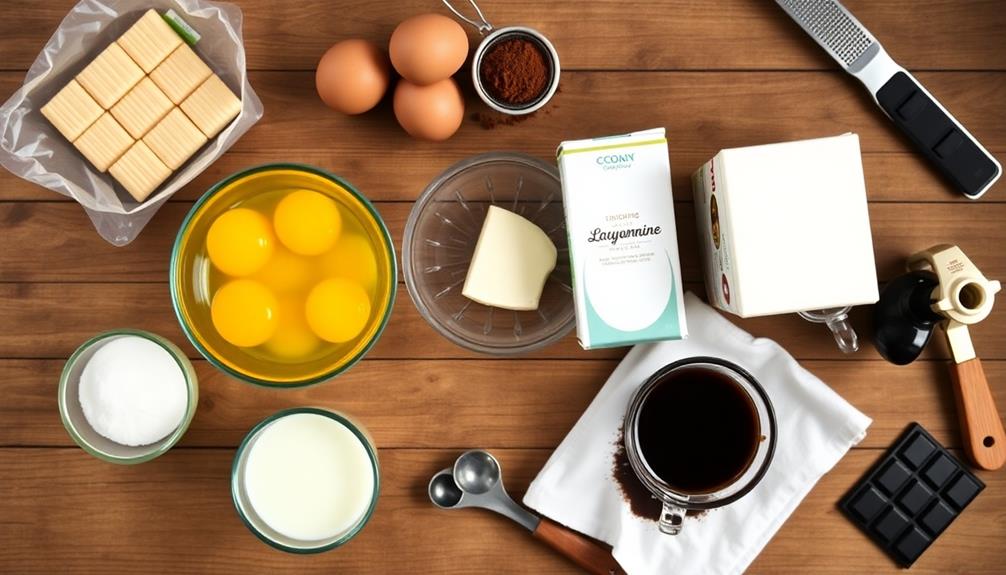
For a light and airy tiramisu, whipping the mascarpone cheese until fluffy is crucial. This step helps create that dreamy texture we all love in this classic Italian dessert. Let's get started! If you’re looking to try another classic Italian dish, consider making a pasta all’amatriciana recipe. This dish features a rich tomato sauce with crispy, salty pancetta, and a hint of spicy red pepper flakes. It’s a delicious and satisfying meal that’s sure to become a new favorite. So, gather your ingredients and get ready to enjoy a taste of Italy!
First, you'll need:
- 16 ounces of mascarpone cheese
- A large mixing bowl
- An electric mixer or whisk
Here's what to do:
- Take the mascarpone out of the fridge 30 minutes before you start.
- Put the cheese in your mixing bowl.
- If you're using an electric mixer, start on low speed.
- Slowly increase the speed as the cheese softens.
- Keep mixing until the mascarpone is light and fluffy.
- This usually takes about 2-3 minutes.
Remember, you don't want to overmix! Stop when the cheese looks smooth and creamy. It should form soft peaks when you lift the mixer.
If you're whisking by hand, use quick, circular motions. It'll take a bit longer, but you'll get there!
Once your mascarpone is fluffy, it's ready to be combined with other ingredients. This step is key to making your tiramisu extra special. Your family will love the silky-smooth result!
Step 2. Mix Egg Yolks With Sugar
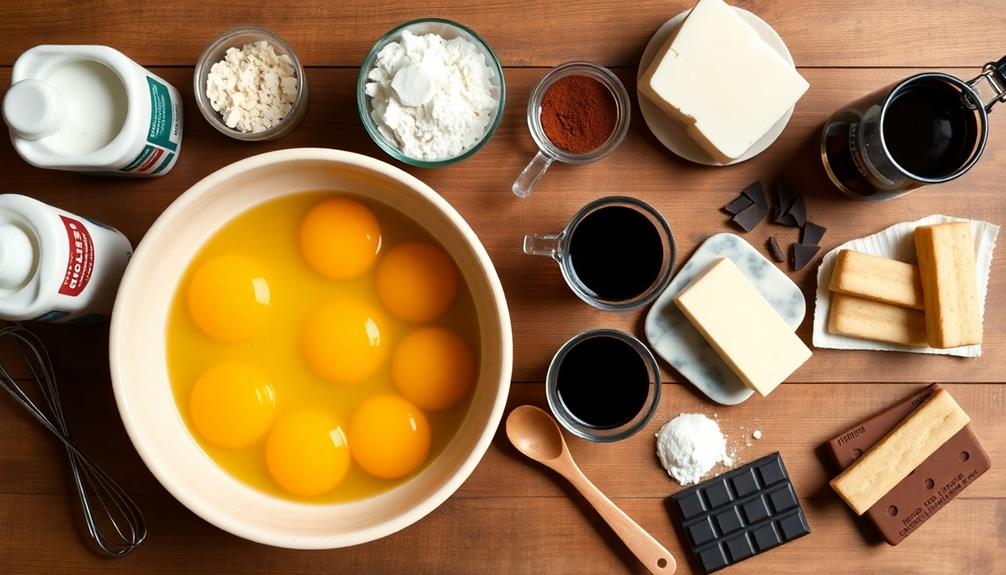
Now that your mascarpone is perfectly fluffy, it's time to focus on another key component of tiramisu: the egg yolk and sugar mixture. This step is super important because it gives your dessert its rich, creamy texture and sweet flavor.
Here's what you'll need to do:
- Separate the egg yolks from the whites
- Put the yolks in a medium-sized bowl
- Add sugar to the yolks
Now, let's mix! You'll want to whisk the yolks and sugar together until they're light and creamy. This might take a few minutes, but don't give up! Keep whisking until the mixture looks pale yellow and feels smooth.
As you mix, you'll notice the color changing and the texture getting fluffier. That's exactly what you want! This process is called "creaming" and it's what makes your tiramisu extra special.
Remember:
- Use fresh eggs for the best results
- Don't rush this step – take your time to get it just right
- If your arm gets tired, take a short break and then keep going
Once your egg and sugar mixture is ready, you're one step closer to enjoying your delicious tiramisu!
Step 3. Dip Ladyfingers in Coffee Mixture
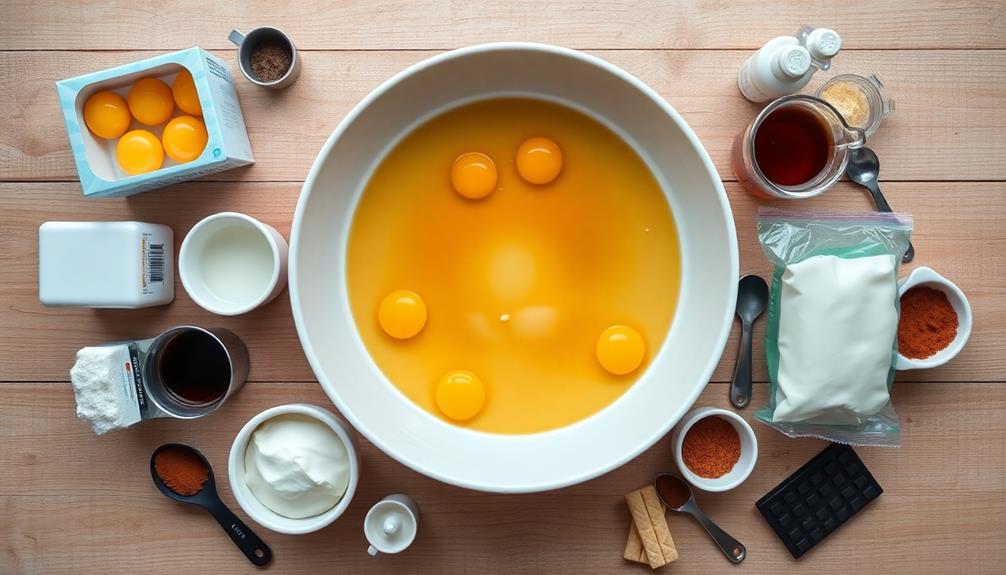
Ready to add some coffee-soaked goodness to your tiramisu? It's time to dip those ladyfingers!
First, grab a shallow bowl and mix together:
- 1 cup strong coffee (cooled)
- 2 tablespoons coffee liqueur (optional)
Now, let's get dipping:
- Hold a ladyfinger by one end.
- Quickly dip it into the coffee mixture for about 1 second.
- Don't soak it too long, or it'll get mushy!
- Place the dipped ladyfinger in your serving dish.
Keep going until you've covered the bottom of your dish with a single layer of coffee-soaked ladyfingers. They should fit snugly together, like puzzle pieces.
Remember, you're building layers here! You'll need enough dipped ladyfingers for two layers, so plan accordingly.
As you dip, you might notice the coffee mixture getting low. No worries! Just mix up a little more if needed.
This step is super important because it gives your tiramisu that rich, coffee flavor everyone loves.
Plus, it's fun to watch the ladyfingers soak up the coffee like little sponges!
Step 4. Layer Mascarpone Cream Mixture
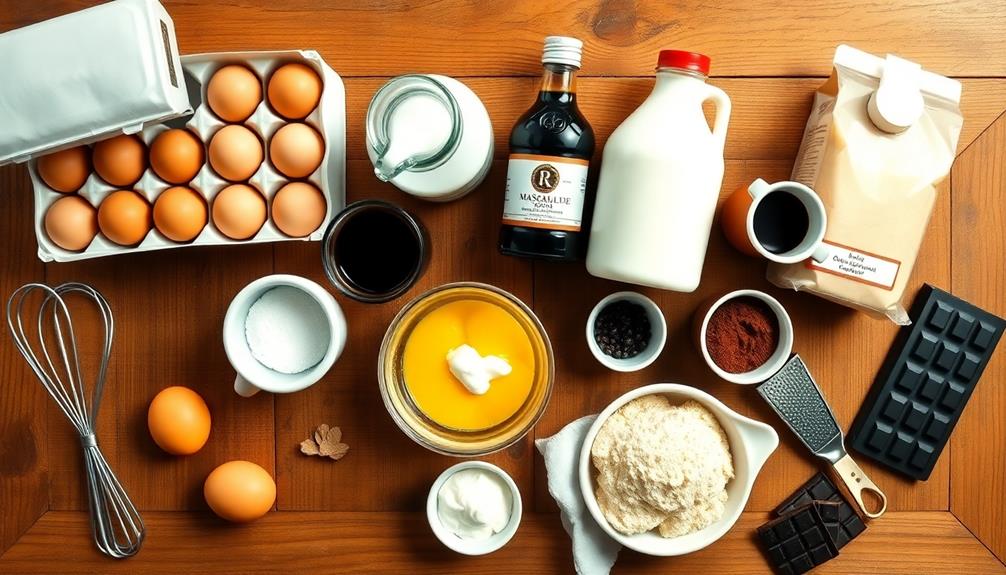
The rich, creamy layer of mascarpone is what truly elevates tiramisu from good to extraordinary.
Now it's time to spread this delightful mixture over your coffee-soaked ladyfingers. Grab a spatula and get ready for some fun!
Here's how to create the perfect mascarpone layer:
- Start with a generous dollop of the mixture in the center of your dish.
- Gently spread it outwards, covering the entire surface of the ladyfingers.
- Make sure to reach all the corners and edges.
- Aim for an even thickness throughout the layer.
As you're spreading, imagine how yummy this dessert will taste when it's done!
The creamy texture will contrast beautifully with the coffee-soaked cookies. If you're making this for a special occasion, you might want to add a little extra love to this step.
Step 5. Chill Overnight Before Serving

After layering your tiramisu, the final crucial step is to chill it overnight. This waiting period might test your patience, but it's absolutely worth it!
Here's why chilling is so important:
- It allows flavors to meld and intensify
- The texture becomes perfectly creamy
- The dessert sets up, making it easier to slice
To chill your tiramisu properly:
- Cover the dish tightly with plastic wrap
- Place it in the refrigerator for at least 6 hours, but preferably overnight
- Resist the temptation to peek or taste!
While you wait, get excited about the delicious treat that's coming. Imagine how proud you'll feel when you serve this classic Italian dessert to your family or friends.
It's perfect for special occasions or just because!
When it's time to serve:
- Remove the tiramisu from the fridge
- Dust the top with cocoa powder or grated chocolate
- Cut into squares or scoop with a spoon
Now, you're ready to enjoy the fruits of your labor. Watch as everyone's eyes light up when they taste your homemade tiramisu.
It's sure to become a family favorite!
Final Thoughts
Whether you're an experienced baker or a novice in the kitchen, tiramisu is a dessert that's sure to impress. This classic Italian treat is perfect for family gatherings, holidays, or just a special weekend treat.
Here's why you'll love making tiramisu:
- It's easier than you think! With simple ingredients and no baking required, you can create a fancy dessert without much fuss.
- The flavors are amazing! Coffee, cocoa, and creamy mascarpone blend together for a taste that's out of this world.
- It's a great make-ahead dessert. In fact, it gets better when you let it chill overnight.
- You can customize it! Try different flavors of liqueur or even make a non-alcoholic version for the kids.
Frequently Asked Questions
Is Tiramisu Safe to Eat During Pregnancy?
You should be cautious about eating tiramisu during pregnancy. It often contains raw eggs and alcohol, which can pose risks to your baby. However, if it's made with pasteurized eggs and alcohol-free, it's generally safe to enjoy.
Can Tiramisu Be Frozen and Thawed for Later Consumption?
You can freeze tiramisu for later consumption. It'll keep for up to 3 months in the freezer. When you're ready to eat it, thaw it in the refrigerator overnight. The texture may change slightly, but it'll still taste delicious.
How Long Does Homemade Tiramisu Last in the Refrigerator?
You'll want to enjoy your homemade treat within 2-3 days for the best taste and texture. If you've stored it properly in an airtight container, it can last up to 4-5 days in the fridge.
Are There Non-Alcoholic Versions of Tiramisu Available?
You'll find plenty of non-alcoholic versions available. You can easily make or buy tiramisu without alcohol. Some recipes substitute coffee or fruit juice for liqueur, while others simply omit it. There's a delicious option for everyone!
What Are Some Common Variations or Flavor Twists on Traditional Tiramisu?
You'll find delicious twists on the classic dessert, like fruity versions with strawberries or raspberries. There's also chocolate tiramisu, green tea tiramisu, and even pumpkin spice variations. Don't forget nutty options with hazelnuts or pistachios.



